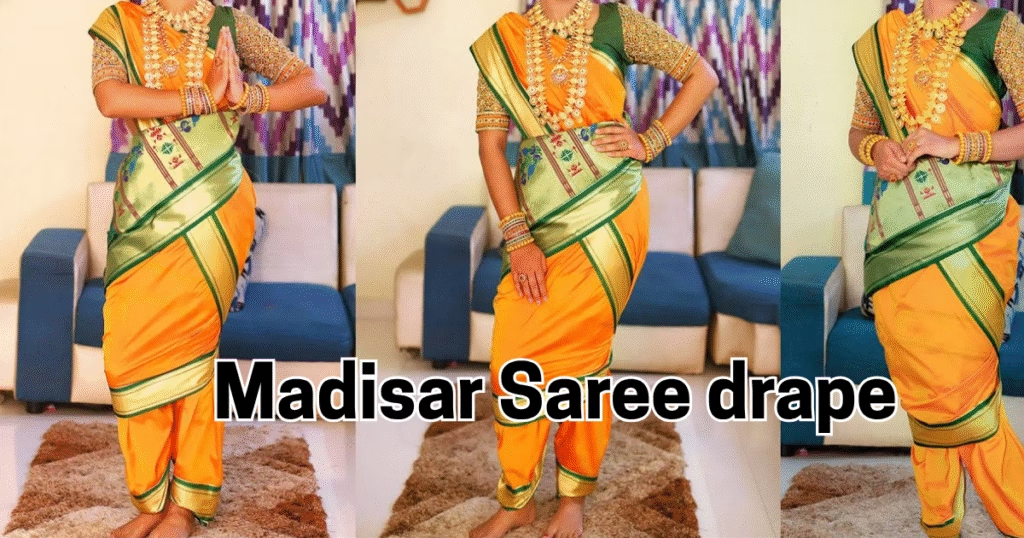
Introduction
The nine-yard drape Madisar saree has great cultural and religious importance in Tamil Brahmin’s. Famous for its peculiar Madisar saree draping style, this saree is more than just a cloth—it’s a glory of legacy, an honest decoration of the spirit and timelessness of elegance. Mainly worn by the married Tamil Brahmin women’s Madisar saree mainly for the occasions of ceremony, functions, and marriage purposes.
In this blog, we explore:



History of the Madisar Saree
The Madisar (or Madisaar) was long part of Tamil Brahmin culture. The name of maidsar is given after a Tamil word called Madisalu which in Tamil language means in the middle to reflect the saree draping pattern called the center-pleated style of draping. In the past, Brahmin women used to wear this nine-yard saree as a symbol of matrimony, devot character and Vedic traditions.
Key Historical Highlights:
- Ancient Roots: References to this fashion of wearing clothing can also be seen in ancient Tamil literature and temple carvings.
- Colonial Influence: During British rule, the style was preserved as a marker of Brahmin identity.
- Evolution: While it was once a part of everyday fashion, it is now rarely worn in everyday life and is usually reserved for religious events, weddings and other ceremonies.
Significance of Madisar Saree Draping
Madisar saree draping is not just about fashion, it is deep rooted with symbolic meaning:
1. Religious & Ritualistic Importance
- The sari is worn in such a way that it covers the head during prayers, symbolizing humility before God.
- The nine yard long cloth has its own significance as it represents the Navgrahas (9 planets) in Hindu astrology, which nourish cosmic well-being.
- The folds are made in such a way to maintain modesty and purity, as these are extremely important during darshan and rituals at the temple.
2. Cultural Identity
- A marker of Tamil Iyer and Iyengar Brahmin traditions.
- Traditionally worn during weddings, upanayanam (thread ceremony), and festivals like Pongal.
3. Practical Benefits
- The dhoti-style draping enables ease of movements hence comfortable to outlast long rituals.
- The pallu (loose end) can be employed to cover the head during the prayers or even used to shield the sun.
Step-by-Step Guide to Madisar Saree Draping
Madisar saree draping requires precision. Here’s a traditional method:
What You Need:



Steps:
- Start with the Petticoat:
- Tie the petticoat tightly around the waist.
- First Tuck (Left Side):
- Begin tucking the saree from the left hip, bringing it around the back to the right hip.
- Forming the Pleats:
- Create 5-7 pleats (each about 5 inches wide) and tuck them toward the left side.
- Bringing the Pallu:
- Take the remaining fabric over the left shoulder, ensuring it covers the back.
- The pallu should be long enough to cover the head during rituals.
- Final Adjustments:
- Secure the pleats with a pin if needed.
- Ensure the saree is neat and symmetrical.

Modern Adaptations of Madisar Saree Draping
While the traditional Madisar remains sacred, contemporary women are reinventing it for modern appeal:
1. Fusion Draping Styles
- Half-Madisar: A shorter version (6 yards) for easier draping.
- Dual-Tone Drapes: Combining two sarees for a stylish contrast.
2. Fashionable Fabrics & Prints
- Silk-Kanjeevaram with modern motifs for weddings.
- Lightweight cotton & chiffon for casual wear.
3. Blouse Innovations
- High-neck blouses for a regal look.
- Sleeveless or cape-style blouses for a trendy twist.
4. Celebrity & Designer Influence
- Designers like Ritu Kumar and Manish Malhotra have showcased Madisar-inspired drapes in fashion shows.
- Actresses like Vidya Balan and Aishwarya Rai have worn modernized versions at cultural events.
Why the Madisar Saree Still Matters
Though the trend of fashion keeps changing, the Madisar saree stays a strong connection to the Tamil heritage. Its spiritual value, classy drape and versatility keep it trendy for birthplace.
Final Thoughts
The Madisar saree draping method is a wonderful mix of custom, prayer and craftsmanship. In its original or slightly modified form, it is still considered a symbol of grace, culture, and somehow eternal beauty.
Have you tried draping a Madisar saree? Share your experience in the comments!
FAQs
Why is the Madisar saree draping differently from regular sarees?
The Madisar saree is a special 9-yard dhoti-style drape designed for religious and cultural usages. This is different from a usual saree as it has center-pleated tucking and a shoulder pallu which when worn rests over the head during namaz keeping traditional Tamil Brahmin traditional modesty and significance of spirituality in check.
Can younger generations adopt the Madisar saree draping for non-religious occasions?
Absolutely! It can also be worn as modernversions such as half-Madisar drapes (with 6 yards), in contemporary blouses, and in lighter materials in case of festivals or weddings or even fusion wears. It is a print that designers are reinterpreted in fashionable prints, but still, keeping their old grace unchanged.
How long does it take to learn Madisar saree draping?
To first-timers, the pleating and the fitting of the pallu might require 2 -3 trial run. Video tutorial or pre-pleated sarees may come in handy. After practice, the amount of time spent on draping becomes only 10-15 min. Tip: Get an Easier Handling Madisar with A Cotton One!

